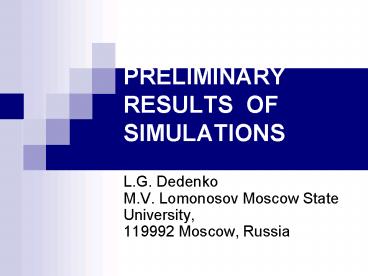PRELIMINARY RESULTS OF SIMULATIONS PowerPoint PPT Presentation
1 / 67
Title: PRELIMINARY RESULTS OF SIMULATIONS
1
PRELIMINARY RESULTS OF SIMULATIONS
- L.G. DedenkoM.V. Lomonosov Moscow State
University,119992 Moscow, Russia
2
CONTENT
- Introduction
- 5-level scheme
- - Monte-Carlo for leading particles
- - Transport equations for hadrons
- - Transport equations for electrons and gamma
quanta - - Monte-Carlo for low energy particles in the
real atmosphere - - Responses of scintillator detectors
- The basic formula for estimation of energy
- Lateral distribution function
- A group method for muons
- The relativistic equation for a group
- Results for the giant inclined shower detected at
the Yakutsk array - Cherenkov radiation
- Conclusion
3
(No Transcript)
4
Transport equations for hadrons
- here k1,2,....m number of hadron types
- - number of hadrons k in bin
EEdE and depth bin xxdx ?k(E)
interaction length Bk decay constant
Wik(E',E) energy spectra of hadrons of type k
produced by hadrons of type i.
5
The integral form
- here
- E0 energy of the primary particle Pb (E,xb)
boundary condition xb point of interaction
of the primary particle.
6
- The decay products of neutral pions are regarded
as a source function S?(E,x) of gamma quanta
which give origins of electron-photon cascades in
the atmosphere - Here a number of
neutral pions decayed at depth x dx with
energies E?dE?
7
- The basic cascade equations for electrons and
photons can be written as follows - where ?(E,t), P(E,t) the energy spectra of
photons and electrons at the depth t ß the - ionization losses µe, µ? the absorption
coefficients Wb, Wp the bremsstrahlung and - the pair production cross-sections Se, S? the
source terms for electrons and photons.
8
- The integral form
- where
- At last the solution of equations can be found by
the method of subsequent approximations. It is
possible to take into account the Compton effect
and other physical processes.
9
- Source functions for low energy electrons and
gamma quanta - xmin(E0E/e)
10
- For the grid of energies
- Emin Ei Eth (Emin1 MeV, Eth10 GeV)
- and starting points of cascades
- 0XkX0 (X01020 gcm-2)
- simulations of 2108 cascades in the atmosphere
with help of CORSIKA code and responses (signals)
of the scintillator detectors using GEANT 4 code - SIGN?(Rj,Ei,Xk)
- SIGN?(Rj,Ei,Xk)
- 10mRj2000m
- have been calculated
11
- Responses of scintillator detectors at distance
Rj from the shower core (signals S(Rj)) - Eth10 GeV
- Emin1 MeV
12
(No Transcript)
13
(No Transcript)
14
(No Transcript)
15
(No Transcript)
16
(No Transcript)
17
- Source test function
- S?(E,x)dEdxP(E0,x)/E?dEdx
- P(E0,x) a cascade profile of a shower
- ?dx?dES?(E,x)0.8E0
- Basic formula
- E0a(S600)b
18
(No Transcript)
19
- Number of muons in a group with hk(xk) and Ei
- here P(E,x) from equations for hadrons D(E,Eµ)
decay function limits Emin(Eµ), Emax(Eµ)
W(Eµ,Ethr,x,x0) probability to survive.
20
Transverse impulse distribution
-
- here p00.2 ???/?.
21
The angle a
-
- here hk hk(xk) production height for hadrons.
22
- Direction of muon velocity is defined by
directional cosines -
- All muons are defined in groups with bins of
energy EiEi?E angles ajaj?aj, - dm dm? dm and height production hk hk ?hk.
The average values have been used , ,
and . Number of muons and
were regarded as some weights.
23
The relativistic equation
- here mµ muon mass e charge ? lorentz
factor t time geomagnetic field.
24
The explicit 2-d order scheme
- here
- Ethr , E threshold energy and muon energy.
25
(No Transcript)
26
(No Transcript)
27
el_ed.jpg
28
ga_ed.jpg
29
pos_ed.jpg
30
(No Transcript)
31
(No Transcript)
32
(No Transcript)
33
(No Transcript)
34
(No Transcript)
35
(No Transcript)
36
(No Transcript)
37
(No Transcript)
38
(No Transcript)
39
(No Transcript)
40
(No Transcript)
41
(No Transcript)
42
(No Transcript)
43
(No Transcript)
44
(No Transcript)
45
(No Transcript)
46
(No Transcript)
47
(No Transcript)
48
(No Transcript)
49
(No Transcript)
50
(No Transcript)
51
(No Transcript)
52
(No Transcript)
53
(No Transcript)
54
(No Transcript)
55
(No Transcript)
56
(No Transcript)
57
(No Transcript)
58
(No Transcript)
59
(No Transcript)
60
(No Transcript)
61
(No Transcript)
62
(No Transcript)
63
(No Transcript)
64
(No Transcript)
65
(No Transcript)
66
CONCLUSION
- In terms of test functions
- The basic formula used for energy estimation at
the Yakutsk array have been confirmed at energies
of 1018 eV. - At energies 1020 eV simulations display larger
energies than this formula shows supporting the
Greizen-Zatsepin-Kuzmin enigma. - Lateral distribution function of signal used at
the Yakutsk array have been confirmed by
simulations. - Estimate of energy of the giant air shower
detected at the Yakutsk array is not less than
31020 eV. - ?257 for 25 d.o.f.
67
Acknowledgements
- We thank G.T. Zatsepin for useful discussions,
the RFFI (grant 03-02-16290), INTAS (grant
03-51-5112) and LSS-1782.2003.2 for financial
support.

